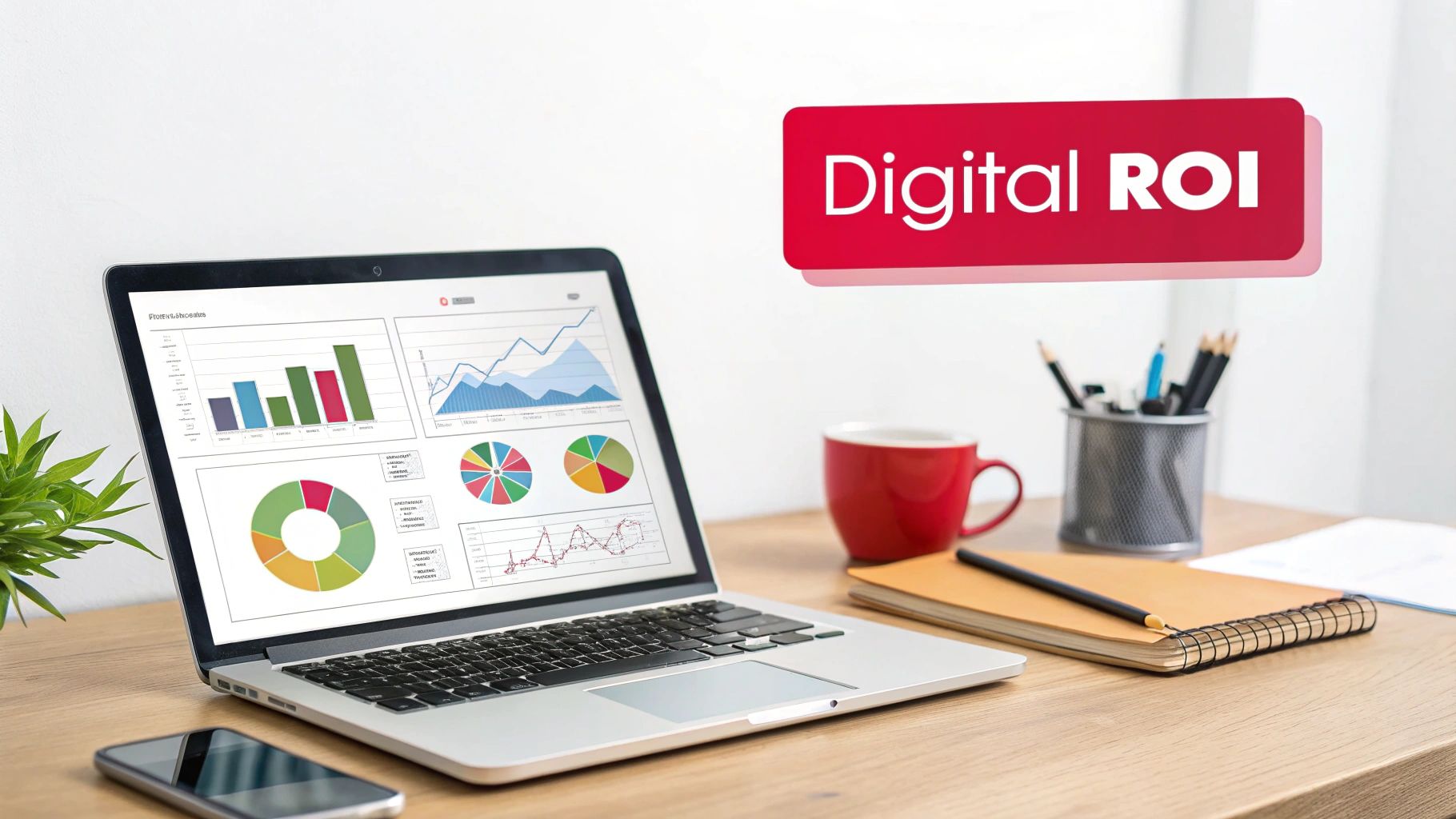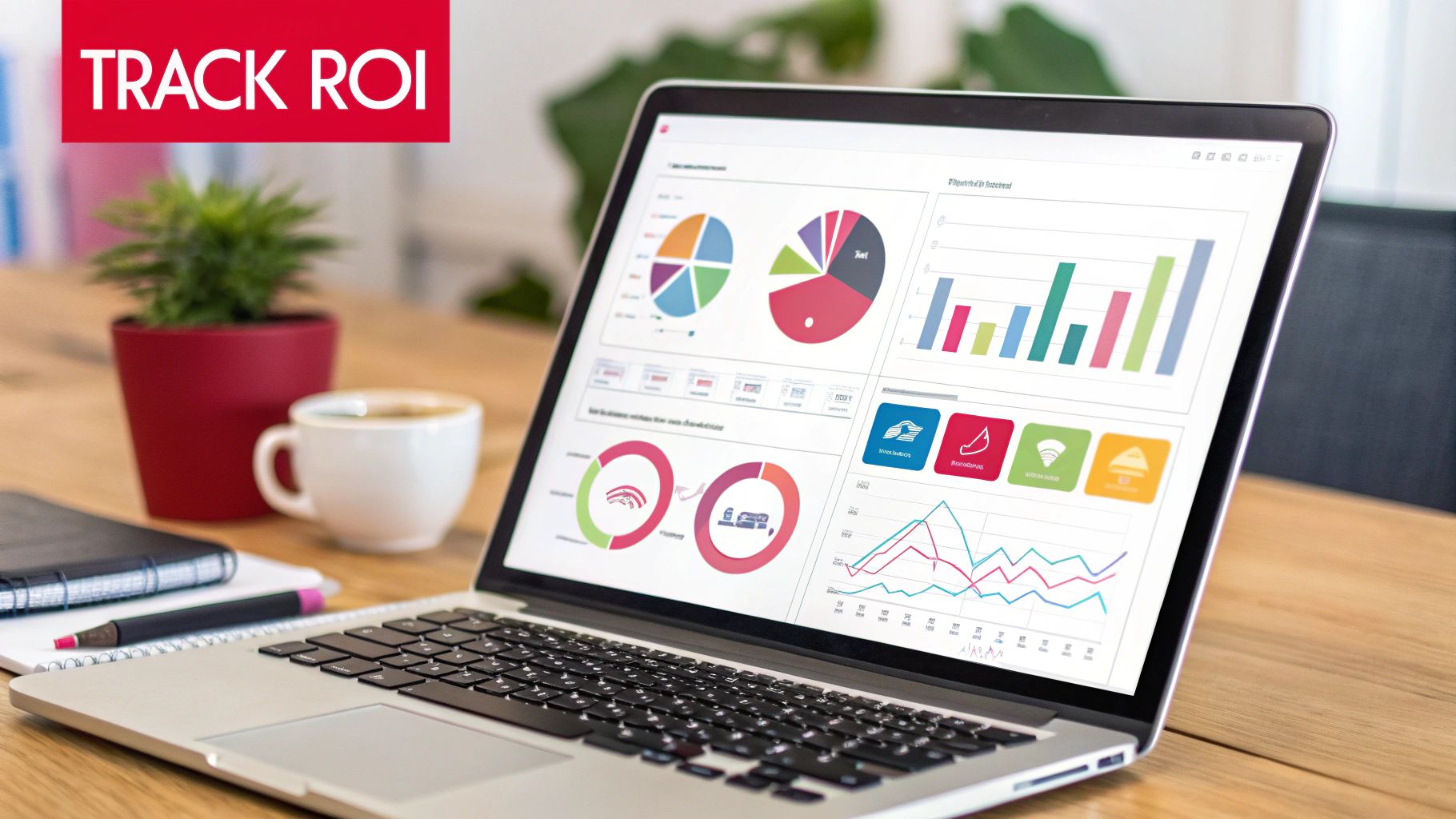
Decoding Digital Marketing ROI in Today's Complex Landscape

Measuring the impact of your marketing efforts is essential, especially in our competitive business world. This is particularly relevant in California, a state with a booming tech industry. Consider the innovative companies in Silicon Valley, as well as thriving tech hubs in Los Angeles and San Diego. These digital landscapes encourage businesses to adopt cutting-edge marketing strategies.
This digital focus is emphasized by the projected expansion of the global digital marketing market. It's predicted to reach $472.5 billion by 2025, with an annual growth rate of 13.6%. In California, businesses are increasingly using digital channels like SEO, paid search, and social media marketing to connect with their target customers. Want to delve deeper into these growth trends? Find more detailed statistics here.
Moving Beyond Vanity Metrics
Traditional marketing measurements often miss the mark in today's intricate online environment. Many companies get caught up in vanity metrics like website traffic and social media followers. While these numbers might look impressive, they don't always reflect actual business results. Digital marketing ROI, however, focuses on the financial returns of your efforts.
This requires a new approach. It's about moving past simply counting clicks and understanding how marketing contributes to revenue growth. This shift in focus can help businesses make more informed decisions about their marketing spend and strategies.
Redefining Success in the Digital Age
Progressive companies are changing how they define success by focusing on tangible outcomes. Metrics like customer lifetime value (CLTV) and return on ad spend (ROAS) are becoming increasingly important. Understanding the long-term value of a customer acquired through a specific digital channel allows businesses to allocate their budgets strategically.
Precisely measuring ROAS is crucial for maximizing the profitability of marketing campaigns. It gives you a clear picture of how much revenue each advertising dollar generates, enabling data-backed campaign optimization.
Overcoming Psychological Barriers
Accurately assessing digital marketing ROI also means addressing psychological hurdles. Many marketers are hesitant to adopt data-driven strategies, often sticking with familiar methods. This resistance might come from a fear of the unknown or a lack of data analytics knowledge.
Overcoming these barriers, however, is essential for accurately measuring and improving marketing performance. Building a data-driven company culture, where decisions are rooted in evidence rather than intuition, is key.
Frameworks for Measuring Impact
Transforming marketing activities into measurable business results requires the right frameworks. These frameworks should be tailored to each business and its unique objectives. For example, an e-commerce business will have different ROI metrics than a business focused on generating leads.
A customized framework helps businesses accurately monitor the financial impact of their marketing strategies. This data can then inform strategic decisions, ensuring that marketing investments contribute to overall business growth. By using this data-driven approach, businesses can optimize their marketing efforts and achieve greater success.
Mastering ROI Calculation: Methods That Actually Deliver
Calculating Return on Investment (ROI) in digital marketing isn't just about formulas. It's about understanding how your marketing impacts your bottom line. This is especially critical in California's competitive business environment, from Silicon Valley to emerging companies in Southern California.
Beyond Basic Formulas: Measuring What Matters
Many businesses find it challenging to effectively measure digital marketing ROI. Standard attribution models often fail to capture the complete customer journey. For instance, a customer might interact with several touchpoints – a social media ad, an email, and a blog post – before buying. Attributing the sale only to the final touchpoint ignores the impact of earlier interactions. This can lead to a skewed understanding of marketing performance.
Measuring long-term value is also key. A single purchase doesn't tell the whole story. Customer Lifetime Value (CLTV), the total revenue a customer generates throughout their relationship with your business, is an important factor. Considering CLTV can significantly change ROI calculations and shape your marketing strategy.
Practical Techniques for ROI Measurement
How can you measure ROI in a way that truly provides actionable information? Consider these practical techniques:
-
Isolate Marketing's Impact: Distinguish the effects of marketing from other elements such as seasonality or economic conditions. This might involve examining sales data during specific campaigns compared to periods without those campaigns.
-
Calculate Both Immediate and Long-Term Returns: Look at the immediate results of campaigns and track the long-term influence on CLTV. This provides a balanced perspective on marketing's contribution.
-
Develop Meaningful ROI Metrics: Select metrics that match your business goals. If lead generation is your focus, concentrate on metrics like Cost Per Lead (CPL) and conversion rate. Check out this guide on How to master data-driven decisions for more information.
Building a Robust Measurement Framework
A strong measurement framework is fundamental for accurate ROI calculation. Here's how to build one:
-
Implementing Tracking Infrastructure: Use analytics tools and platforms like Google Analytics to track website traffic, conversions, and other important data. Accurate data collection across all channels is essential.
-
Choosing the Right Attribution Model: Pick a model that reflects your customer journey and accurately distributes credit among touchpoints. Explore multi-touch attribution models for a more comprehensive picture.
-
Regularly Reviewing and Refining Your Approach: Digital marketing is constantly changing. Review your framework regularly, adapting based on data and best practices.
To help illustrate the potential return from different digital marketing channels, let's look at a comparison table.
Digital Marketing Channel ROI Comparison
A comparison of average ROI across different digital marketing channels based on industry data relevant to California businesses.
| Marketing Channel | Average ROI | Implementation Complexity | Time to Results | Best For |
|---|---|---|---|---|
| Email Marketing | $42 for every $1 | Low | Short | Building relationships, promoting offers |
| Social Media Ads | Varies widely | Medium | Medium | Brand awareness, targeted reach |
| Search Engine Optimization (SEO) | High, long-term | High | Long | Organic traffic, brand authority |
| Pay-Per-Click (PPC) | Varies widely | Medium | Short | Driving immediate traffic, targeted conversions |
This table highlights some key differences in ROI, implementation difficulty, and time to see results across various digital marketing channels. While email shows a strong average ROI, it's important to remember that results can vary greatly based on your specific industry, target audience, and campaign execution. Channels like SEO and PPC require more complex strategies, yet offer substantial long-term returns and quick wins, respectively.
Measuring ROI effectively can be a challenge. Only 36% of marketers can accurately measure it, and 47% struggle with multi-channel attribution. Yet, digital channels like email marketing demonstrate strong ROI potential, with averages around $42 return for every $1 invested. The importance of ROI is growing, with 83% of marketing leaders prioritizing it, up from 68% five years ago. For more detailed statistics, check out this resource: https://www.firework.com/blog/marketing-roi-statistics. Developing robust ROI measurement strategies is essential for businesses to gain valuable insights and succeed in the digital world.
Channel-Specific ROI: Where Your Marketing Money Works Hardest

Not every marketing channel yields the same return. Finding the right avenues for your budget requires careful consideration. How can you ensure your marketing spend delivers optimal results? Analyzing performance data across different industries offers valuable insights into which channels consistently provide a strong digital marketing ROI. This is especially crucial in California's competitive market, where consumers are often digitally savvy.
Understanding Channel Effectiveness
Several factors influence a channel's effectiveness. Understanding your target audience is paramount. Where do your ideal customers spend their time online? If your demographic skews younger, platforms like TikTok or Instagram might outperform LinkedIn.
The complexity of the purchase also matters. Longer sales cycles, common with high-value purchases, often benefit from email marketing and content marketing to nurture leads.
Finally, the competitive landscape shapes channel effectiveness. If competitors dominate a specific channel, exploring less saturated alternatives can provide a competitive edge.
Debunking the "Dead Channel" Myth
Some channels, like email, are occasionally dismissed as outdated. However, email marketing can be surprisingly effective, sometimes outperforming trendier platforms. For instance, email remains a powerful tool for direct-to-consumer brands, offering personalized customer engagement. This highlights the importance of a synergistic channel strategy over reliance on isolated tactics.
Speaking of effective strategies, The Purple Store, an online retailer, saw a 400% return on ad spend (ROAS) using Google Ads. This success story, achieved by focusing on niche audiences, underscores the potential of targeted online strategies. Furthermore, digital marketing boasts an average ROI 28% higher than traditional methods, making it a compelling choice for budget optimization. While California-specific data may be limited, these examples illustrate the potential of digital marketing for reaching target audiences and maximizing ROI. Learn more about digital marketing ROI.
Identifying Your Optimal Channel Mix
The ideal channel mix depends on your specific business goals and how customers interact with your brand. Factors like industry, target audience, and budget all contribute to finding the right blend.
California Industry Benchmarks
To illustrate, let's examine industry-specific ROI benchmarks relevant to California businesses. The following table offers a glimpse into channel performance across various sectors:
The table below provides a general overview of "Digital Marketing ROI Benchmarks for California Industries". It showcases industry-specific ROI benchmarks across various digital marketing channels relevant to major California business sectors.
| Industry | SEO ROI | PPC ROI | Social Media ROI | Email Marketing ROI | Industry-Specific Considerations |
|---|---|---|---|---|---|
| Technology | High, long-term | Medium to High | Medium | High | Focus on thought leadership and technical content. |
| E-commerce | Medium to High | High | Medium | High | Optimize product listings and use retargeting campaigns. |
| Healthcare | Medium | Medium | Low to Medium | Medium | Ensure compliance with regulations and focus on patient education. |
| Tourism/Hospitality | Medium | Medium to High | High | Medium | Invest in visual content and target specific travel interests. |
These benchmarks offer a general perspective, and actual results can vary. Continuous performance tracking is essential.
This data reveals the potential of different digital channels across various industries. While e-commerce may see strong returns from PPC, technology companies might find greater benefit in long-term SEO strategies. Understanding these industry benchmarks, coupled with your unique business needs, enables strategic budget allocation for maximum impact and sustainable growth.
Breaking Through ROI Measurement Barriers That Plague Marketers

Measuring the return on investment (ROI) for digital marketing can be challenging. Let's explore some of the common hurdles marketers face and discuss effective solutions for navigating today's complex online environment.
Solving the Multi-Touch Attribution Puzzle
One of the biggest obstacles is multi-touch attribution. Customers rarely convert after just one interaction. They may see a social media ad, then click a search result, visit your website several times, and subscribe to your newsletter before finally purchasing. So, how do you accurately assign credit to each step?
Leading organizations are turning to advanced analytics platforms like Google Analytics to track these cross-channel interactions. These platforms provide a more comprehensive view of the customer journey.
This comprehensive perspective allows marketers to gain more accurate insights into how each touchpoint contributes to conversions. They can then optimize their strategies by investing in the most impactful interactions.
Bridging Online and Offline Conversions
Many businesses, from local shops to larger companies, need to connect online activity to offline conversions. For example, a customer might see an online ad and then visit a physical store to make a purchase. How can this be tracked effectively?
Several solutions are available. One option is to incorporate unique promotional codes into online campaigns and track their redemption in-store. Another method is using surveys at the point of sale. This helps gather information about the customer journey and link it back to online engagements.
These techniques provide a fuller picture of the customer experience, bridging the gap between the digital and physical worlds.
Measuring Long-Term Brand Impact
Digital marketing ROI isn't solely about immediate sales. Brand awareness and customer loyalty are also essential for long-term growth. However, these long-term effects can be difficult to quantify.
Savvy marketers utilize brand lift studies and sentiment analysis to measure how campaigns influence brand perception. This approach goes beyond immediate transactions and focuses on creating a strong brand presence. Check out this resource: How to master SEO and content strategies for your blog. These methods help gauge the long-term effectiveness of your marketing efforts and brand building strategies.
Navigating Privacy-Focused Environments
Increasing privacy concerns and restrictions on tracking methods have added another layer of complexity to measuring digital marketing ROI.
Marketers are adapting by emphasizing first-party data and direct customer relationships. This involves focusing on strategies that encourage customers to willingly share information, such as loyalty programs and personalized email marketing. Furthermore, privacy-preserving analytics techniques are gaining importance. These practices allow for data collection while respecting customer privacy.
Practical Approaches and Frameworks
To effectively measure digital marketing ROI in this ever-changing environment, consider the following:
-
Isolate Marketing's Contribution: Compare data during marketing campaigns to periods without activity to isolate and understand marketing's true impact.
-
Comprehensive Measurement Frameworks: Implement a framework that encompasses the entire customer journey, from initial awareness to post-purchase behavior.
-
Meaningful ROI Reporting: Clearly communicate findings to stakeholders, highlighting how marketing contributes to overall business objectives. This reinforces the value of marketing investments and facilitates strategic decision-making. A consistent approach to measurement and reporting ensures that marketing efforts remain aligned with business goals, resulting in more successful campaigns.
Transforming Your Digital Marketing ROI Through Strategic Optimization

Measuring your digital marketing ROI is essential. But optimizing it for continued growth is even more critical for long-term success. This section explores practical strategies to achieve consistent improvement and higher returns on your marketing investment.
Data-Driven Testing for Continuous Improvement
Savvy marketers understand the importance of data-driven decision-making. They use data not just for reporting but to constantly test and refine their campaigns. This iterative approach, often involving A/B testing, allows businesses to experiment with different ad creatives, landing pages, and even email subject lines.
For example, a tech startup might A/B test different headlines on their landing page. This helps determine which version resonates most effectively with their target audience and generates more leads. By continually analyzing and adjusting based on data, campaigns are constantly being optimized, leading to incremental performance gains and maximized ROI.
This agile approach also allows for quick adjustments based on real-time performance signals. In today's competitive market, reacting efficiently to these signals is crucial for staying ahead.
Audience Segmentation for Increased Effectiveness
Effective marketing isn't about shouting your message to the masses. It's about speaking directly to the right people with the right message. Audience segmentation involves dividing your target audience into smaller, more defined groups based on shared characteristics.
This allows for more personalized and targeted messaging. An e-commerce business, for instance, might segment its audience based on past purchases, demographics, or browsing behavior. They could then create separate email campaigns for new customers versus returning customers, each with unique messaging tailored to their needs.
This level of personalization significantly boosts campaign effectiveness. By delivering relevant content to each segment, you improve engagement and drive higher conversions. This ultimately translates to a higher ROI, ensuring your marketing budget is used efficiently by targeting customers most likely to convert.
Creative Optimization: Engaging Content on a Budget
Creative optimization focuses on maximizing engagement without necessarily increasing ad spend. This might involve refreshing your existing ad creatives with new imagery or copy, or experimenting with different video formats for social media platforms like YouTube.
A winery, for instance, might create short, engaging video content showcasing their vineyards and winemaking process to connect with their audience. This approach can revitalize existing campaigns and combat ad fatigue.
By finding innovative ways to engage your audience, you can improve performance without dramatically increasing costs. This is particularly valuable for businesses operating with tighter budget constraints. Looking for more creative optimization strategies? Check out this resource: How to master creative optimization strategies.
Competitive Intelligence: Gaining a Market Advantage
Understanding your competition is vital for maximizing ROI. Competitive intelligence involves analyzing your competitors' strategies, strengths, and weaknesses. This research can offer valuable insights into industry best practices and identify opportunities to differentiate your approach.
This might involve analyzing competitor ad creatives, identifying their target keywords, or researching their social media presence. Knowing your competitors' moves allows you to pinpoint areas where you can outperform them and gain a competitive edge.
By understanding the competitive landscape, you can inform your overall marketing strategy and focus your budget on the most effective tactics. This strategic allocation maximizes ROI by targeting areas with the greatest potential for success.
Building a Culture Where Digital Marketing ROI Thrives
Achieving a strong digital marketing ROI isn't simply about choosing the right strategies. It's about cultivating a company culture that prioritizes ROI in every business decision. This requires a level of organizational alignment that many companies struggle to achieve. So how do you build a team that values data-driven results?
Aligning Marketing and Sales: A Shared Vision for Success
Marketing and sales teams often operate in silos, each with their own distinct goals and metrics. Aligning these teams around shared revenue targets is crucial for maximizing ROI. A shared focus ensures everyone is working towards a common objective.
One effective way to achieve this alignment is by implementing a Service Level Agreement (SLA) between the two teams. An SLA can clearly define lead qualification criteria and handoff processes. This clarity fosters collaboration and reduces friction, ensuring high-quality leads are nurtured effectively.
Rewarding Impact, Not Vanity: Incentive Structures That Drive Results
Many traditional incentive structures reward activity, not outcomes. Shifting this focus requires rewarding teams based on their contribution to revenue. Consider tying bonuses to metrics like customer lifetime value (CLTV) or return on ad spend (ROAS).
By linking rewards to financial impact, teams are motivated to focus on strategies that generate tangible results. This promotes a more data-driven and results-oriented approach to marketing as a whole.
Cross-Functional Collaboration: Breaking Down Silos
Maximizing digital marketing ROI often requires collaboration beyond just marketing and sales. Finance teams can offer valuable budget insights and track marketing's impact on the bottom line. Product teams can provide crucial product knowledge that enhances marketing messaging.
By facilitating open communication between these teams, you create an environment where insights are shared and efforts are aligned for more effective marketing campaigns.
Communicating Marketing's Impact: Speaking the Language of Executives
Marketing teams need to effectively communicate their impact to executive leadership. This requires clear, concise reporting focused on financial outcomes. Presenting data that directly links marketing activities to revenue generation demonstrates the value of your work and secures buy-in for future initiatives.
Reports could highlight the ROI of specific campaigns, for example, or demonstrate the contribution of marketing to overall business growth. This data-driven reporting helps executives see the real impact of marketing efforts and strengthens the position of the marketing team within the organization.
Building Analytical Capabilities: Empowering Your Marketing Team
Invest in training programs to equip your marketing team with the analytical skills necessary to understand and improve ROI. Focus on data analysis, campaign measurement, and optimization techniques.
Upskilling your team empowers them to make data-driven decisions, analyze campaign performance, and identify areas for improvement. This knowledge fuels continuous optimization and elevates your overall marketing ROI. It also increases team engagement and ownership of campaign success.
Shifting to an Outcome-Based Culture: Embracing Change
Transforming a company culture to be outcome-based requires a considered change management approach. Begin by clearly communicating the benefits of the shift and providing the necessary training and support.
Regularly sharing success stories and celebrating achievements reinforces the importance of a data-driven approach. This positive reinforcement motivates teams to embrace an outcome-based mindset and continually improve. Acknowledging and rewarding progress fosters a positive attitude towards change within the organization.
Ready to elevate your digital marketing and achieve remarkable results? WebFluence Digital LLC provides the tools and resources you need to succeed. Explore our comprehensive suite of digital marketing solutions, including SEO-optimized templates, conversion-driven lead funnels, and business automation resources designed to help you build, grow, and dominate your market. Visit WebFluence Digital LLC today and unlock your full digital potential.










